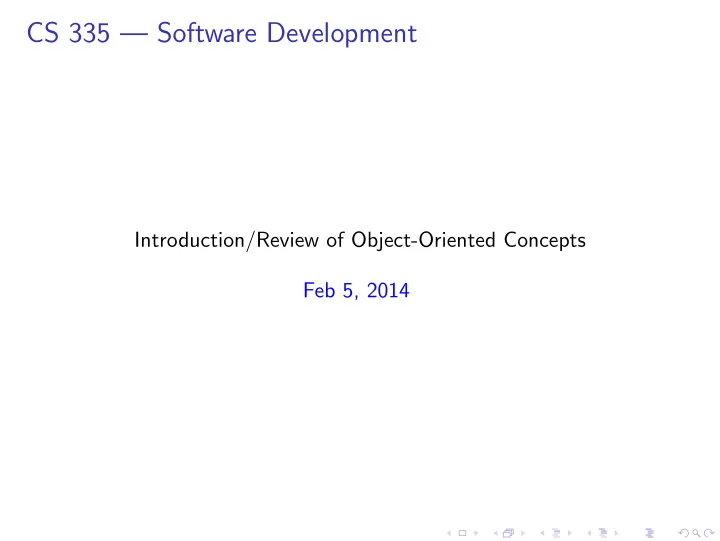

CS 335 — Software Development Introduction/Review of Object-Oriented Concepts Feb 5, 2014
Objects return Jan 12, 2009; + dateProduced(): long + color(): Color return WHITE; + calories(): int return 300;
Objects don’t need classes typedef int Color; unsigned long int _dateProduced() { return 862547416; } Color _color() { return 0; } int _calories() { return 300; } struct { unsigned long int (*dateProduced) (); Color (*color)(); int (*calories)(); } aWhiteCake = { _dateProduced, _color, _calories } ;
Several similar objects return Jan 12, 2009; return Jan 14, 2009; + dateProduced(): long + dateProduced(): long + color(): Color + color(): Color return WHITE; return WHITE; + calories(): int + calories(): int return 300; return 300; return Jan 12, 2008; + dateProduced(): long + color(): Color return WHITE; + calories(): int return 300;
Classes WhiteCakeLayer class WhiteCakeLayer { − date : long private long date; public WhiteCakeLayer() { + dateProduced(): long + color(): Color date = System.currentTimeMillis(); + calories(): int } public long dateProduced() { return date; } return long; public Color color() { return Color.WHITE; } return WHITE; public int calories() { return 300; } } return 300; “An object’s implementation is defined by its class . The class specifies the object’s internal data and representation and defines the operations the object can perform.” DP, pg 14
UML Scott Adams. c � 1995, Universal Features Syndicate
What has changed? :WhiteCakeLayer :WhiteCakeLayer return Jan 12, 2009; return Jan 14, 2009; + dateProduced(): long + dateProduced(): long + color(): Color + color(): Color return WHITE; return WHITE; + calories(): int + calories(): int return 300; return 300; :WhiteCakeLayer return Jan 12, 2008; + dateProduced(): long + color(): Color return WHITE; + calories(): int return 300;
Commonality among classes class WhiteCakeLayer { private long date; public WhiteCakeLayer() { date = class ChocolateCakeLayer { System.currentTimeMillis(); public Color color() { } return Color.BLACK; } public long dateProduced() { public int calories() { return date; } return 500; } public Color color() { } return Color.WHITE; } public int calories() { class VelvetCakeLayer { } return 300; public Color color() { } return Color.RED; } public int calories() { class YellowCakeLayer { return 450; } public Color color() { } return Color.YELLOW; } public int calories() { return 400; } }
Types “The set of all signatures defined by an object’s operations is called the interface to the object. An object’s interface characterizes the complete set of requests that can be sent to the object. Any request that matches a signature in the object’s interface may be sent to the object. A type is a name used to denote a particular interface.” DP, pg 13 “It’s important to understand the difference between a object’s class and its type . An object’s class defines how the object is implemented. The class defines the object’s internal state and the implementation of its operations. In contrast, an object’s type only refers to its interface—the set of request to which it can respond. An object can have many types, and objects of different classes can have the same type.” DP, pg 16
Subtyping <<interface>> CakeLayer + color(): Color + calories(): int WhiteCakeLayer YellowCakeLayer ChocolateCakeLayer VelvetCakeLayer
Liskov substitution principle If for each object o 1 of type S, there is an object o 2 of type T such that for all programs P defined in terms of T, the behavior of P is unchanged when o 1 is substituted for o 2 , then S is a subtype of T. Barbara Liskov, “Data Abstraction and Hierarchy,” SIGPLAN Notices , 23.5, May 1988. If a value of type S can be substituted into any context where a value of type T is expected, then S is a subtype of T.
Interchangeablility <<interface>> Frosting Cake 2 − layer1:CakeLayer <<interface>> − layer2: CakeLayer CakeLayer − fill: Filling <<interface>> − frost: Frosting Filling + color(): Color + calories(): int + calories() : int return layer1.calories() + layer2.calories() + fill.calories() + frost.calories() WhiteCakeLayer YellowCakeLayer ChocolateCakeLayer VelvetCakeLayer
Class extension Cake − layer1:CakeLayer − layer2: CakeLayer − fill: Filling − frost: Frosting + calories() : int WeddingCake BirthdayCake − candles: Candle[] − decoration : Sprinkles + age() : int
Class extension vs. interface implementation “It’s also important to understand the difference between class inheritance and interface inheritance (or subtyping). Class inheritance defines an object’s implementation in terms of another object’s implementation. In short, it’s a mechanism for code and representation sharing. In contrast, interface inheritance (or subtyping) describes when an object can be used in place of another. “It’s easy to confuse these two concepts, because many languages don’t make the distinction explicit.” DP, pg 17
Inheritance and reuse “Because inheritance exposes a subclass to details of its parent’s implementation, it’s often said that ”inheritance breaks encapsulation.” The implementation of a subclass becomes so bound up with the implementation of its parent class that any change in the parent’s implementation will force the subclass to change.” DP, pg 19
Two principles Program to an interface, not an implementation. DP, pg 18 Favor object composition over class inheritance. DP, pg 20
Suggestions from Effective Java ◮ 13: Minimize the accessibility of classes and members. ◮ 14: In public classes, use accessor methods, not public fields. ◮ 15: Minimize mutability. ◮ 16: Favor composition over inheritance. ◮ 17: Design and document for inheritance or else prohibit it. ◮ 18: Prefer interfaces to abstract classes ◮ 19: Use interfaces only to define types. ◮ 20: Prefer class hierarchies to tagged classes ◮ 21: Use function objects to represent strategies ◮ 22: Favor static member classes over nonstatic. Joshua Bloch, Effective Java , Addison-Wesley, 2008. Pg 67–108
Recommend
More recommend